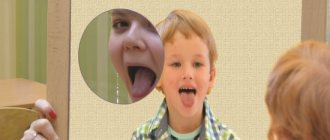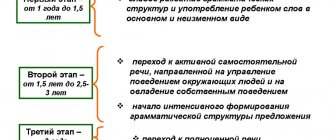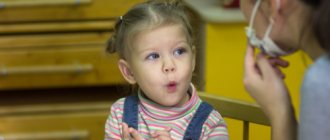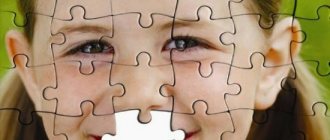A child’s speech development is a complex and lengthy process, which includes enriching vocabulary, understanding spoken words, and the ability to express one’s own thoughts, feelings, and desires. Each age has its own leading activity and its own norm of speech development. Speech development also includes the ability to compose sentences, phrases, and change words by cases and tenses.
What is normal speech development
Psychologists and speech therapists distinguish three main periods in the development of speech:
- Preparatory (from birth to 1 year).
- Pre-school (from one year to 3 years).
- Preschool (3 – 7 years old).
They are broken down into smaller stages. In each period, a child - with normal speech education and development - must master certain communication skills and learn specific things. For example, by the age of 3-4 years, a child’s vocabulary should already reach 3000-4000 words. The older the child, the more extensive and varied his lexical baggage should be, the easier it becomes for him to communicate with others. If some stage is missed, development is stopped (for example, by the age of three the child is still at the “booming” stage), then the norm has been violated, it is necessary to turn to specialists for help.
Parents need to know the norms of speech at a certain age and develop these skills, without overestimating them, but also not underestimating them. At first, you should not overload your child with learning poems and songs that are not appropriate for his age.
Speech therapist advice
If a neurologist or psychiatrist diagnosed your child with speech development delay (speech development delay) during the first examination, do not panic. Each child has a reserve of time up to 3 years when he can begin to speak. This can happen in a year, ahead of development according to WHO standards, or closer to 3 years. The main thing is to undergo a full examination in case of speech underdevelopment in order to exclude the presence of pathologies of a neurological or organic nature.
If, in addition to the developmental disorder, doctors do not give the child any concomitant diagnoses, the child is completely healthy, speech delay is his individual feature, he will speak later. Parents can help the baby cope with a difficult task faster, for this they need:
- read more fairy tales, sing songs, tell stories and poems to the baby;
- walk in the fresh air and communicate with the baby while walking, discussing surrounding natural phenomena;
- play outdoor and board games, pronouncing colors, shapes, seasons, etc.;
- collect pyramids, cubes, mosaics with your child;
- talk more with the baby, even if he cannot yet fully respond to an adult;
- visit theaters, performances, circus museums.
Enough time should be allocated to communicate with the child. It is advisable to stop watching TV shows and computer games. Attention and parental love will help in speech development and creating a good base for acquiring new knowledge.
What influences the proper development of speech?
There are two groups of factors that influence speech development:
- Biological.
- Social.
The first include various pathogenic factors that can harm proper development: complex intrauterine development, brain infections and injuries, hearing impairment, heredity.
The second group is a combination of the child’s internal development processes and external conditions that are specific to each age stage. For example, the early separation of a baby from his mother sometimes causes emotional instability, impulsiveness, and behavioral disturbances. And this, in turn, leads to speech disorders.
Good conversation is influenced by examples and role models. The child first hears how they speak in the family, so he begins to try it himself. In order to correctly assimilate words during play activities, the child first accumulates impressions - this is the basis for future images and connections with them in speech. The development of gross motor skills also affects the correctness of conversation. The development of speech skills is influenced by the language a child learns to speak. An attempt to master several languages at once may slightly slow down a child’s development; his speech may develop more slowly.
In no case should a child be punished for mistakes in speech, teased or corrected with irritation. This can cause withdrawal and reluctance to try further.
The role of the family in the formation of speech reserve is key. Parents study poems and songs, recitations with their child, teach the child to speak at the right speed, and respond to his attempts to carry on a conversation.
Proper speech development is promoted by:
- Emotionally positive environment;
- Peace of mind in the family;
- Moderate sound communication between loved ones (no shouting);
- Feeling of security in the family;
- Patience of parents towards the child;
- Sensitive and friendly behavior of kindergarten teachers.
Main stages of speech development
Speech refers to the highest mental function. It depends on how developed the central nervous system is. It is both a means of communication and the basis of thinking. From the moment of birth, the baby finds himself in a social environment, which means he begins to listen and learn to communicate with the outside world. To be sure that development is going in the right direction, you need to know the norms and pathologies of speech for each age stage.
Speech of a child from 2 months to a year
This stage of development can be roughly divided into three stages.
- Booming. From 2 to 5 months. The child begins to intonate his cry, indicating his condition. Humming sounds appear, they are combined with vowels, they arise in communication with parents, and this is the child’s first conscious communication with adults (agu, agi, ge, aa, uh). At the same time, you can see the first smile, hear the child’s first laugh.
- Babble. This period lasts the longest - about seven months, up to one year. Syllables appear (la, yes, pa), word chains (pa-pa, la-la-la), and then the first words, for a start - consisting of identical syllables (pa-pa, ba-ba, ma-ma) . The speech apparatus is already configured to perform various movements, and unique sound combinations are heard (ma-ma-ma, la-la-pa).
- First words. By the first year of life, the child learns to pronounce his first words. Usually there are about 20-25. And they consist of the same syllables. During this period, the child begins to correlate what he says with specific actions, people, objects (the appearance of his mother - “ma-ma”, etc.). At this time, the baby is very actively engaged with toys, learns their names, is able to hear, perceive and find the desired object, not yet being able to name it independently (he will not say that it is a “cat”, but will find a cat among the toys).
Ideally, by the end of the first year of life, speech becomes the child’s main way of communicating with adults.
| Number of months from birth | Speech skills |
| 2 | Pronunciation of individual sounds, the appearance of the first spontaneous vocalizations, usually directed towards an adult. |
| 3 | Experimenting (stretching) with vowel sounds - “uh-uh”, “a-a-a”, “o-o-o”, humming, “cooing” (chest gurgling sounds). |
| 4 | The transformation of individual sounds into entire roulades and the flow of one sound into another - “o-o-o-o-o-o”. |
| 5 | The appearance of random babbling, rhythmic humming, the combination of vowels with some consonant sounds - “gu-gu-gu”, “bu-bu-bu”. |
| 6 | Improving random babble (“na-na-na”, “da-da-da”), merging vowel/consonant sounds, trying to imitate audible sounds, establishing a kind of dialogue with people around. |
| 7 | Frequent repetition of babbling, understanding the meaning of some words, the appearance of semantic pauses (the child babbled something and fell silent, waiting for an adult to answer). |
| 8 | Using babble as a way of communication, trying to pronounce different sounds and their echolalia (repetition without awareness of the meaning). |
| 9 | It is possible (but not necessary) that the first lightweight words “ba-ba”, “ma-ma” will appear, and babbling will become more complex. |
| 10 | Carefully listening to the speech of adults, expanding passive vocabulary, pronouncing new syllables and simple words (quite rare) - “av”, “na”. |
| 11 | An increase in the number of lightweight words or their appearance (if there were none before), semantic content of words and syllables (one word or syllable can have several completely different meanings). |
| 12 | Ability to understand more than 20 words, pronunciation of 5-10 simplified words, improvement of imitation. |
Lesson on speech development in the preparatory group of a preschool educational institution
Norms of speech development from 1 year to 2 years
The next year of the baby’s life is a continuation of the previous stage. The first 12 months have prepared the articulatory apparatus, and the child is already actively using his own words. He knows how to imitate animals and everyday sounds around him. The following stages of development are distinguished:
- The child recognizes individual objects and understands questions regarding them: “where is the cube?”, “where is the girl?” etc. It can accompany its action with words and sounds. “Talks” with other children using sounds and imitation.
- The baby knows the names of objects and their qualities, emotional assessments. The first meaningful words: cat “meow-meow”, dog “aw-aw”, etc. Sounds may be skipped.
- Understands simple sentences that call for action: “Let’s go eat,” “Give me, please,” etc. Words generalize concepts, for example, “av-av” means all dogs at once, not a specific one. There are already about 30-40 words in the vocabulary.
- By the age of one and a half years, he pronounces almost all vowels and some consonants. Some of them soften. Sound substitutions occur (“ko” – milk). The dictionary has been expanded to 40-95 words. Speech is dominated by gestures, sounds, and facial expressions.
- Imitates adults as much as possible. He turns to them with requests: “Dad, give me!” Knows how to connect words into sentences: “Katya wants la-lya” (a doll). Speech becomes self-sufficient, gestures and facial expressions disappear.
- Knows how to replace incorrectly pronounced words with the correct ones: “la-la” - “doll”. By the age of one year and 9 months, he normally knows about 175 words, using 3-4 in sentences.
- Listens to fairy tales, poems and songs, distinguishes words by sounds (does not confuse mustache and ears). Indicates your actions during the game. Uses pronouns and adjectives.
- Recognizes words that relate to events in his own life. “We are going for a walk in the park, where we met a big dog.” Speech develops very actively when playing with dolls and animals. By the age of 2, the dictionary contains about 300-400 words. Most often - noun and verbs. Adverbs are added: here, here.
Norms of speech development for children aged 3 to 4 years
The writer Korney Chukovsky called this stage in a child’s life a period of “brilliant linguistic giftedness.” At this time, kids are engaged in a kind of creativity: they come up with their own words and names, entire structures, rhyme, compose, create concepts known only to themselves. What characterizes this age for speech:
- The vocabulary already contains 1500–2000 words. The norm is some distortion of difficult to pronounce words, rearrangement of syllables.
- Sentences are built from three to four words; at 4 years old he can pronounce common sentences.
- Complex and even complex constructions and homogeneous members are used.
- They actively use adjectives, pronouns, adverbs, and numerals.
- He can already pronounce vowels without making them soft. Phonetic errors are still the norm. For example, hissing ones are replaced by whistling ones.
- Difficulties arise with the letters “l” and “r”.
- The speech is generally not very coherent; there are some descriptive elements (“This is a cat. She drinks. She is soft.”).
- They easily remember and repeat poems, nursery rhymes, and songs by heart.
- An understanding of the rhythm and volume of speech comes. But kids are not yet able to regulate them on their own.
- They know how to reason and draw conclusions.
- State your first name, last name, patronymic, and the names of relatives and friends.
- Summarizes objects into groups, determines the signs of objects (hot tea, sweet honey) and actions (mom is sleeping, dad has come).
Norms of speech development from 4 to 5 years
At four years old, a child’s language is varied and precise, emotionally vivid. He asks questions and is happy to read and listen. And:
- The vocabulary consists of 2500-3000 words.
- Accurately names objects and their qualities.
- He comes up with his own words and even poems.
- There are many adjectives and prepositions in speech.
- There are more personal pronouns
- A child can form a logically correct statement from several sentences.
- Monologue speech and retelling are mastered.
- Able to clearly and colorfully describe an object, picture, or toy.
- Almost all sounds are pronounced correctly (there may be exceptions with “L” and “R”; they take the longest to form).
- Able to reduce sound volume and speak in a whisper.
- He doesn't speak quickly.
- Uses expressive intonation to read poetry.
Norms of speech development for children 5 – 7 years old
By the age of six, a child can already speak freely with peers and adults. Ideally, by the age of seven, he is ready to master the school curriculum and does not experience communication difficulties. What characterizes this period:
- Many collective nouns and adjectives appear, denoting states and abstract concepts.
- Knows how to use general concepts (“Transport” is an airplane, a bus, and a car).
- Knows and distinguishes between seasons, plants, animals, berries, mushrooms, birds, fish, etc.
- Knows where right is left; how much time.
- Uses the names of days of the week, days, months.
- Knows the name of the country and capital.
- Operates with geographical concepts.
- Knows the rules of pedestrian traffic.
- Declines nouns according to numbers and cases.
- Able to agree nouns with numerals, and adjectives with nouns.
- Uses all parts of speech correctly
- Speech is coherent, able to retell a fairy tale or story.
By the age of seven, there are almost no errors in speech, all sounds are clear, the accents are correct.
| Child's age in months/years | Speech skills |
| 18/1,5 | The presence in the active vocabulary of 5-20 words, mainly nouns. Frequent repetition of one phrase or word, willing repetition of emotionally charged jargon (“eat”, “kitsia”, “musenka”, etc.), the ability to fulfill simple requests. |
| 24/2 | The ability to name different objects from one’s environment, the use of several prepositions, sometimes not entirely correctly (on, under, in). Composing short sentences - “let me drink”, “look, kitsya”, having in the active vocabulary from 100 to 300 words. Occasionally correct use of the pronouns “I”, “you”, “me”. The question “what is this?” appears. |
| 36/3 | Correct use of pronouns, occasional use of some nouns in the plural and verbs in the past tense. Correct use of at least three prepositions – for, on, under; ability to correctly name and show body parts. The active vocabulary ranges from 900 to 1000 words, and the child’s speech is 90% understandable to others. Understanding complex questions (“Are you hungry now?”) and the ability to give an adequate answer to them. |
| 48/4 | Correct use of at least 4 prepositions. Understand and reproduce the names of familiar animals and various objects in magazines or books. Correct repetition of words with four syllables, understanding the ratio of big/small, many/little. Easy fulfillment of simple requests, frequent repetition of various syllables, sounds, phrases and words. |
| 60/5 | Use of many descriptive words – adverbs and adjectives; speech is 100% understandable to adults, despite the possible presence of some articulation problems. Repeating sentences up to nine words; the ability to name household items and understand what they are needed for. Distinguishing between the concepts of today/yesterday/tomorrow; fulfilling three consecutive requests; reducing the number of grammatical errors in speech. |
| 72/6 | The ability to roughly navigate time, compose a coherent story from a picture. The presence of more than 2000 words in the active vocabulary; the emergence of questions “why?”, “why?”, rapid enrichment of vocabulary. |
| 84/7 | Mastery of coherent speech, the ability to retell a text heard or read. There may be small errors when pronouncing complex sentences with participial phrases. Modulation of intonation and volume of the voice, correct articulation of all sounds. Replenishment of active vocabulary up to 3500 words, improvement of speech attention and intensive development of logical thinking. |
Speech therapy massages, games and fun exercises
Age norms by month
Average indicators of speech development are important for determining normality or pathology. They can shift depending on the individual characteristics of the baby and the conditions of his growth. It is known, for example, that every serious illness suffered by a young child “throws him back” a little in terms of the development of skills and abilities.
- The first month and a half of life. Sounds appear with which the child reacts to the speech of the mother and other close people addressed to him. These are mainly vowel sounds and their combinations (o, a, u, ya, ay, ua). The child is able to focus his gaze on the faces of his relatives, on the toys shown to him, and listen to the sounds of human speech. During this period, children with prerequisites for a future speech disorder can be identified by assessing the nature of their cry - shrill or very quiet; sobs or screams are possible while inhaling, and not while exhaling, as is expected during normal development.
- At 2–3 months, the “revival complex”, consisting of characteristic movements of the arms and legs at the sight of the mother, is accompanied by guttural sounds and their combinations with vowels (a-a-a, a-a-gi, a-a-gu, a- ha). Such hooting occurs not only when in contact with familiar close people. It can occur spontaneously when the baby is full and happy, or when looking at a toy. Another achievement of this stage is auditory and visual concentration on the source of sound or movement.
- At 3–5 months, the child seeks contact with adults with his gaze, smile, and utters drawn-out sounds - humming. They most often consist of sound combinations such as gee, khy, agu, aga, ga, ege, aa. Sometimes these combinations are so bizarre that they are difficult to reproduce. The pathology at this stage is considered to be monotonous humming sounds accompanied by chaotic movements of the arms and legs, and a lack of intonation expressiveness.
- At the 6th month of life, babbling appears in the child’s speech, consisting of such combinations of sounds as “ga, ka, pa, ma.” Constantly repeating themselves, they already become quite similar to models of words, as if pronounced syllable by syllable: “ma-ma-ma-ma, ba-ba-ba.” Such improvisations appear only in a good mood, and for now they cannot be a means of communication. During this period, congenital deafness can be diagnosed, because a deaf child has no babbling, and the sounds of humming gradually fade away.
- At the 7th month of life, a connection appears between an object and the word denoting it. If parents specifically pay attention to this skill, show objects and toys, naming them several times, then the child will quickly learn to look for them at the request of an adult. Words must be clearly distinguishable by sound. In a child with delayed speech development, babbling is absent or manifests itself in separate elements, the baby does not imitate the movements of an adult, and does not follow the simplest verbal commands.
- By the end of the first year of life, on average, a child’s active vocabulary contains from 10 to 25 words. Along with correctly pronounced words (dad, baba, uncle, lalya), these can also be babbling words (am, bobo, bang), and partially pronounced forms of words (“kach” - swing, “zya” - impossible), as well as onomatopoeia with animal voices and surrounding sounds (meow, ha-ha, beep). By this time, the connection between the word and the object it denotes should be established. By the end of the first year of life, speech is ideally a means of communication between a child and adults.
You should be wary if the baby prefers to express his desires with gestures, facial expressions and mooing instead of words. By the end of the first year of life, such manifestations are not considered a deviation from the norm if, in addition to them, words are also used in communication.
Speech therapy classes for speech development
Independent activities with your child to develop and strengthen communication skills can be done at home.
- Fine motor games (finger)
- Articulation gymnastics
- We develop hearing, onomatopoeia and logorhythmics (poems with various movements).
- Games for hearing development, games for sound imitations and logorhythmics (poems with movements).
- We learn and read poems to expand our vocabulary.
- Speech imitation. Show a model of behavior (birds, mothers, cats) and ask the child to reproduce with the necessary sounds (the cat purrs “purrr...”)
- Poems with action. Tell a poem, illustrating it.
- Reading.
- Development of fine motor skills. For example, decorate clothes with clothespins and ask the child to take them off.
- Mandatory sensory development (use taste, touch, smell in games).
- Guess which object is ringing; guess where the sound is coming from; imitate everyday sounds.
Muscle strengthening exercises
- "Smile". Stretch your lips in a smile, hiding your teeth. Hold for up to 30 seconds.
- "Fence". Smile so that all your teeth are visible. Hold the smile.
- “Punish the tongue.” Open your mouth a little, put your tongue on your lower lip, slap it with the sound “five-five-five.”
Parents' mistakes
Often it is the inattention of parents that leads to disturbances in the child’s speech. The main mistakes that are made in the family:
- Lack of help for the baby. Parents do not pay attention to communication.
- Adults “lisp”, distorting speech, giving the child the wrong role models.
The child remembers that his parents like his soft, childish pronunciation and is in no hurry to get rid of it, thus receiving love.
- Ignoring developmental delays.
- Reluctance to correct speech (including your own, for example, pronunciation defects, haste).
- Poor speech experience in a child. The baby is simply not taught to talk, and it is difficult for him to communicate, he does not know how to do this.
- Parents are tired and not ready to talk; it is easier for them to provide their child with a computer or phone with games.
- Adults read little to children.
Two to three years of mastering the grammar of the language
The number of words in the child’s phrases has increased and continues to increase. The sentence is built according to a linear principle: a key word and non-main words. Words in a sentence acquire a grammatical connection.
During this period, the child begins to master changing words by numbers, genders, and cases. But some grammatical categories are difficult for him. Such “difficulties” include the declension of nouns by case, and sometimes the use of the correct gender. For example, a two and a half year old boy can say “I went”, “I did”, and this is the age norm. The most important thing is that during this period the child’s speech becomes understandable regardless of the situation in which it is spoken.
The child begins to think verbally, that is, not only in images, but also in words. Inner speech appears. At three years old, the child begins to master the system of his native language.
When to see a speech therapist
There are several conditions under which you need to seek help from a specialist.
- There is no humming or babbling.
- By two years, the vocabulary is completely undeveloped or the child does not speak at all.
- Does not pronounce simple sounds or replaces them (“k” with “t”, etc.).
- If by the age of three the baby speaks a language that only he understands.
- The child understands everything, reacts to everything, but does not speak.
- If at 4-5 years old speech is slurred, many sounds are not pronounced.
- If after the age of five the child continues to speak softly (“kisya”).
- By the age of six, individual sounds are not pronounced correctly.
- Speaks with hesitation, repeats syllables, stutters.
- A child over 6 years old cannot learn a poem or retell what he heard.
The way a child talks speaks volumes about his mental health. And if there are any hints of deviations from the norm, it is best to contact a specialist. He will tell you whether it is possible to straighten your speech at home or whether you need classes with a doctor. If correct speech is not formed by the age of seven, problems with learning and communication may arise, which will reduce the child’s quality of life in the future.
One to two years first words and phrases
The child’s first words are not words that define an object or subject, but verbs containing a request (demand): “give,” “na,” etc. The number of first words depends on the state of mental development, so their number can vary greatly among different children. Often, only people from his immediate environment can understand the meaning of what a child said.
By the age of one and a half years, the first words begin to be combined into two-word sentences and phrases. They cannot yet be called a proposal in the full sense of the word. It is quite difficult to even understand them if you are not aware of the situation. By the age of 2, the number of words in sentences increases. And the child’s vocabulary itself is actively increasing. Words in phrases begin to be divided into a reference word and a variable.











